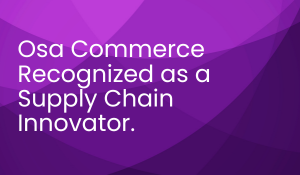Unlock Knowledge, Fuel Your Success.
Osa Commerce keeps brands, retailers, and logistics providers up to date on the latest supply chain innovations, trends, and thought leadership.
In a recent poll, 81% of procurement leaders anticipate a data-driven revolution in the next decade—with artificial intelligence (AI) expected to have the largest transformative impact.
The rapid growth of e-commerce has fundamentally changed how the retail industry operates today. The rise of online shopping has brought new opportunities, but it has also created significant challenges for retailers, logistics providers, and third-party logistics companies (3PLs).
In today's highly competitive market, businesses are increasingly focused on the optimization of logistics by reducing logistics costs while improving efficiency. Supply chain technology plays a crucial role in this effort.
Since my time working with third-party logistics (3PL) businesses, brands, retailers, and other technology partners, one thing has remained constant: The Bottom Line.
Supply chain businesses are only as reliable as their commitments to their customers. This requires a large amount of accountability to ensure workflows, processes, and service level agreements (SLAs) are met. It also necessitates a need to control and regulate the businesses ability to oversee these activities in a visible and collaborative way.
Order accuracy is not just a metric—it’s a fundamental aspect of a successful supply chain operation. Order accuracy refers to how precisely a company fulfills its customers' orders, ensuring that the right products reach the right customers in the right quantities and at the right time.
Discover how automation is revolutionizing modern supply chains, enhancing efficiency, and streamlining operations in ways that go beyond traditional robotics. Supply chain automation now encompasses a broad spectrum of innovative solutions.
With the Olympic torch making its journey from Paris to Los Angeles for the 2028 Games, the anticipation and preparation are palpable among athletes and the city alike. In the realm of the supply chain, we too are gearing up, constantly adapting and fine-tuning our strategies for what lies ahead.
The retail industry has undergone rapid transformation over the last few years, particularly accelerated by the COVID-19 pandemic. This period has seen a dramatic shift in consumption patterns, channel preferences, and heightened customer expectations for speed and convenience.
Atlanta— AUGUST 5, 2024 — Osa Commerce, the leader in real-time supply chain orchestration and visibility, today announced that Paul Boothe, former President of Last Mile and Managed Transportation at RXO/XPO Logistics and former Ryder System, Inc. Senior Director of Global Transportation Procurement, has joined the company as executive board advisor.
The beauty e-commerce sector is booming, with leading websites like Ulta and QVC seeing millions of monthly visits. In March 2024, ulta.com alone saw around 30 million visits in the United States, and qvc.com saw approximately 24.64 million visits. These numbers highlight the immense demand and the rapid growth of online shopping within the beauty industry.
Supply chain management has come a long way. In the past, organizations relied on siloed operations and manual processes to manage their supply chains. However, with the rise of ecommerce and omnichannel businesses, it has become clear that a more integrated and efficient approach is needed.
The retail industry has continuously shown increased revenue growth each year. The technology surrounding the industry has subsequently evolved with it, from the introduction of social media to online shopping to omnichannel strategies to artificial intelligence (AI). The addition of these innovative technologies have helped shape the way that modern-day consumers shop.
We're sharing our top strategies that can help you optimize your inventory management and ultimately boost your profitability. By implementing these key tactics, you'll not only reduce your inventory turns but also streamline your operations for maximum efficiency. Discover how they can transform your brand or 3PL (third-party logistics) for the better.
In the beauty industry, efficient inventory management is crucial to handle high SKU counts and seasonal fluctuations with ease. With the right warehouse management solutions, you can effectively track and manage your inventory, ensuring that you always have the right products in stock.
The objectives of order orchestration—such as optimizing supply chain operations, providing excellent customer experiences, reducing costs, and improving accuracy—are achieved through the implementation of various rules and strategies.
Unleash the untapped power of your supply chain with these tried-and-tested strategies that are guaranteed to boost your bottom line, exceed customer expectations, and ensure seamless order fulfillment. By implementing these innovative approaches, you can revolutionize your inventory management, elevate the customer experience, streamline operations, and make data-driven decisions that propel your business towards unparalleled success.
Order orchestration is an automated process that manages the entire lifecycle of an order— from its inception to fulfillment. It involves coordinating the critical activities across different supply chain systems and departments to ensure that an order is processed efficiently and accurately.
Last-mile delivery stands out as a critical component of supply chain management. It refers to the final step in the delivery process, where a product is transported from a distribution center to the end customer's location. This phase is crucial as it directly impacts customer satisfaction and the overall efficiency of the supply chain. Businesses today are increasingly focusing on optimizing last-mile delivery to ensure quick, reliable, and cost-effective service.
Imagine the supply chain as a relay race. Each segment of the race represents a stage in the supply chain, and each runner is a key player in the process. Just like in a relay race, the success of the supply chain depends on the smooth and timely passing of the baton from one runner to the next.
First, let's define what EDI integration is and what it can offer us. Electronic Data Interchange (EDI) integration for the supply chain involves the use of standardized electronic formats to exchange business information between trading partners.
One of the most important steps for a retailer or brand in 2024 is having an online presence. To get you started on this, Shopify recently released a Step-by-Step Guide of How to Start an Online Store. As a supply chain technology platform that integrates with Shopify along with 440+ other preset integrations, we wanted to share our top tips for choosing the right e-commerce Platform for your business needs and goals.
Brands and retailers have been able to use ecommerce and omnichannel sales as significant growth factors. So much in fact that brands have adopted omnichannel functionality and features to meet the growing needs of consumers.
In a recent conversation with a well known brand, I encountered a familiar quest: the search for a "Magic Button." This brand, with over 30,000 SKUs, has been relying on intuition and gut feel to determine the optimal slotting of products within their warehouse for over 15 years. Each season, they rely on their intuition to know when to move the former season's clothing to the back and the new season's clothing to the front, a process that has become increasingly inefficient and time-consuming.
Order fulfillment is a comprehensive process that begins when an order is placed by a customer or a sale is made and concludes when the customer receives the ordered product. This intricate process is essential to supply chain management and involves several critical steps to ensure timely and accurate delivery.
Ensuring customer satisfaction is crucial for Brand and Retailer businesses aiming to thrive. However, there are several common pain points that can significantly hinder the customer experience. Addressing these issues can make a substantial difference in retaining loyal customers and driving growth.
In the ever-evolving landscape of supply chain management, the concept of Fourth Party Logistics (4PL) has emerged as a strategic solution for businesses seeking comprehensive and streamlined logistics operations. But what exactly is 4PL, and how does it differ from traditional logistics models? Let's delve into the definition, role, and advantages of 4PL to understand its significance in modern supply chains.
Welcome back to class! In our first course, Supply Chain 101, we touched on the basics and history of the supply chain industry. We are now going to be covering more advanced supply chain topics in this course, Supply Chain 102.
The order management process is a crucial component of any supply chain business, encompassing various stages from order placement to fulfillment and beyond. Let's explore the key steps involved in the order management process and how businesses can optimize each stage to streamline operations and enhance customer satisfaction with.
In today's marketplace, Third-Party Logistics (3PL) businesses are increasingly investing in supply chain technology to generate ROI. By understanding the impact of supply chain technology on ROI, businesses can make informed decisions about their investments.
It can be complicated to make sure the entire process from procurement to last-mile delivery is seamless. Ensuring that all inventory goes to the right place at the right time can also be rather fickle. That’s why you need end-to-end communication throughout your logistics operations to connect the dots of your entire supply chain.
In the realm of logistics and supply chain management, the efficiency of warehouse operations stands as a cornerstone for success. Effective warehouse management principles not only streamline processes but also contribute significantly to cost reduction, customer satisfaction, and overall business growth.
White-labeling technology refers to the process of rebranding a product or service developed by one company as if it were created by another company. In the context of supply chain businesses, white-labeling technology enables these companies to offer their customers a branded experience by creating customized portals and interfaces.
In order to effectively scale supply chain businesses, it is crucial to understand the importance of Warehouse Management Systems (WMS) in supply chain operations. WMS plays a vital role in optimizing processes and improving overall efficiency. By implementing a robust WMS, businesses can streamline their operations, track inventory accurately, and ensure timely delivery of goods.
Precision forecasting is crucial for 3PLs to effectively manage their inventory. By accurately predicting demand and understanding customer buying patterns, companies can ensure they have the right products available at the right time. This not only minimizes the risk of stockouts but also reduces excess inventory and associated holding costs.
Creating a successful supply chain has never been so important—especially for Third Party Logistics (3PL) warehouses. This year is poised to have yet another impressive market projection of $1.3tn USD, making it the absolute most important time to get processes and systems in order. In addition, evolving consumer demands and technological innovations increase the need for businesses to require seamless integrations across various channels to offer complete supply chain visibility.
If you're wondering why it is necessary to measure your supply chain performance, it all boils down to the ability to improve and positively affect the bottom line. For example, it can allow you to fix many elements of your supply chain like improve customer satisfaction, increase efficiency, cut costs, decrease risks, breakdown data siloes, and overall increase connectivity.
Global supply chains serve as vital arteries connecting businesses and consumers across continents. Recent initiatives, such as the establishment of the White House Council on Supply Chain Resilience and Canada's National Supply Chain Office, underscore the growing awareness of fortifying the world’s supply chains against disruptions.
Supply chain visibility is crucial for businesses to effectively manage their operations. It allows brands, retailers, and third-party (3PL) and fourth-party (4PL) logistics partners to have a clear understanding of the movement of goods and information throughout supply chain operations—from procurement to delivery.
Today meeting and exceeding customer expectations is non-negotiable. A customer anticipates the arrival of a delicate, high-value product—let's say, the latest smartphone. In this scenario, flawless last-mile delivery isn't just a perk, it's a strategic imperative.
Picture this: a trendy omnichannel beauty brand, renowned for its innovative products and loyal customer base, found itself in a bind. Despite their expertise in crafting captivating cosmetics, they were instead grappling with the unpredictable nature of inventory management and trying to solve supply chain visibility challenges.
Fashion Week, a cornerstone of the fashion industry and an absolutely essential part of the supply chain, traces its roots back to the mid-19th century when Parisian couturiers began showcasing their latest designs to clients and the press. Since then, this tradition has evolved into a global phenomenon, with major fashion capitals like New York, Milan, London, and Paris hosting biannual events where designers unveil their newest collections.
For someone who attended the University of Kansas (KU), March Madness holds immense significance and excitement. The NCAA tournament represents a time to come together and cheer for our favorite teams. It celebrates the under-dogs, dynasties, and Cinderella stories.
Imagine this scenario: Your warehouse not only houses your inventory but also possesses the ability to predict unexpected peaks in sales. Picture a world where an influencer promotes a beauty brand to their substantial following in Utah, causing a sudden surge in demand in that region. In this rapidly evolving landscape, the power of artificial intelligence (AI) is not just a technological marvel but a strategic advantage that can revolutionize the way third-party warehouses operate.
Social media has completely transformed the way retailers approach marketing. It has evolved from being a simple communication and networking tool to becoming a powerful marketing platform. In the past, retailers heavily relied on traditional distribution channels to reach their target audience. However, with the rise of social media, they now have the opportunity to connect directly with consumers in a more personal and engaging way.
The third party logistics (3PL) market is highly competitive and expected to continue growing due to factors such as e-commerce, social selling, and younger generations finding innovative ways to shop. In 2023, the 3PL industry generated $258.9 billion in revenue. This figure is projected to reach $1.3 trillion in 2024 and $1.68 trillion by 2029.
Return season can be a challenging time for any business, especially around the holiday season when return policies can be a little muddled. Many retailers have complicated processes or insufficient data. Some have challenges with sustainability or green promises. Others cite numerous issues with fraud. Unfortunately, there are companies who struggle with all of these issues. However, with the right technology, supply chain businesses can mitigate the impact of returns and, in some cases, prevent them altogether.
It has been just over one week since Manifest Vegas 2024 wrapped. Some may say, “what happens in Vegas, stays in Vegas.” Boy, I really hope that isn’t true. This year showcased incredible speakers, innovative exhibitors, and forward-thinking thought leaders among the 4600+ supply chain and logistics attendees.
In the realm of supply chain management, the distinction between ecommerce and omnichannel strategies holds critical significance. As a leading provider of supply chain solutions, it's imperative to dissect these approaches and their implications thoroughly. Let's delve into the nuanced differences between them while emphasizing the pivotal role of Collaborative Visibility—a technology platform fostering comprehensive supply chain integration and visibility.
Embarking on the journey of implementing a Warehouse Management System (WMS) is a strategic move for any business aiming to enhance its supply chain efficiency. Supply chain technology is crucial for those looking to remain nimble, easily scale and grow revenue. WMS solutions also help reduce risks, increase visibility, and enhance operations—not just third-party logistics (3PL) warehouses—but also brands and retailers who work closely with their warehouse partners.
Continuing with our three-part exploration of "The Right Technologies for an Intelligent Supply Chain," our previous entry took a dive into the pivotal role of effective change management. We discussed the importance of upskilling to adapt to new industry standards and the integration of AI within supply chains.
Supply chain risk mitigation strategies ensure a business's resilience and stability. In today's interconnected global marketplace, disruptions arise due to natural disasters, geopolitical tensions, or sudden market shifts. Proper supply chain risk management shields organizations from adverse side effects in response to these disruptions.
Welcome back to our three-part series on The Right Technologies for an Intelligent Supply Chain. In our last blog we focused on Spatial Web, balancing artificial intelligence (AI) and human experience, and the benefits AI brings to decision support for c-level executives.
Lumping in the trucking industry refers to the process of having third-party workers unload freight, often in the food sector. Lumping companies fill a supply chain gap, sparing truck drivers from unloading responsibilities in exchange for a lumper fee. These fees, charged at the time that external labor is hired, are reimbursed by the shipper, receiver, or consignee, as mandated by U.S. law.
This was my first year attending and I was excited to hear from supply chain thought leaders and the opportunity to network with many women that I connected with through social media. I was also joined by two Osa Commerce Women In Logistics winners, Yifat Baror co-founder and Chief Growth Officer and Wendy Wolff, Director of Operations. These ladies were honored alongside the 341 women named winners.
Successfully navigating this surge requires more than just logistical expertise; it demands a mastery of data insights across your entire supply chain. Let’s explore why a Warehouse Management System (WMS) is crucial and dive into how not all WMS solutions are created equal.
Keeping track of your inventory is essential for preparing for customer demand and creating informed decisions for your business. Paper-and-pencil inventory systems may still work, but advanced technologies offer more accurate results that save time and reduce costs. With these systems, you can lighten your workload and streamline your operations. Keep reading to learn more about digital inventory management systems and why it's important to implement one.
Welcome to "Supply Chain 101", where we'll explore the ins and outs of the world of supply chain management. This journey takes us from its humble beginnings to the intricate global network it is today, and peeks into what the future holds. Whether you're a curious mind, a budding entrepreneur, or just looking to understand the fascinating world of supply chain and logistics, you're in the right place. So, grab a cup of joe, and let's start class!
The world of supply chain management continues to evolve with technological advancements, ranging from artificial intelligence (AI) to the emergent spatial web. In this rapidly changing landscape, businesses must learn to quickly adapt or risk future success. We had the opportunity to delve into an insightful discussion with Gene Tyndall, Co-Founder of eMate Consulting and an expert in supply chain innovation.
Vendor managed inventory (VMI) is a game-changer redefining the rules of e-commerce. VMI is a supply chain strategy involving the supplier taking a more active role in managing a customer's inventory levels. The supplier checks the customer's stock levels, predicts demand, and refills the inventory as required. VMI seeks to collaborate resulting in reduced supply chain costs, enhanced inventory accuracy and a simplified process.
Staying ahead of the curve is not just an advantage; it's a necessity. This is especially important for supply chains. The flow of goods from manufacturers to consumers is a delicate dance that relies on precision, planning, and anticipation. And when it comes to anticipation, nothing holds more weight than a well-crafted inventory forecast.
In today's fast-paced business world, supply chain technology has become a critical component of success. Companies that fail to adapt and upgrade their supply chain systems risk being left in the dust with outdated and inefficient processes. So, is it time for a supply chain technology update? We'll explore why staying current with supply chain technology is essential and what you need to know to stay ahead of the curve.
With the rapidly evolving technology landscape and increasing customer demands, businesses can surely benefit from hopping on the digital bandwagon. In a study by McKinsey & Company, 70% of respondents reported using automation in one or more business processes to streamline repetitive day-to-day tasks.
Recently, Padhu Raman, co-founder and Chief Product Officer at Osa Commerce joined Tom Raftery with Digital Supply Chain to speak about the intricate and fascinating world of supply chains.
In this episode, Breaking Data Silos: A Deep Dive with Osa Commerce, they speak to the critical importance of eliminating data silos, emphasizing data quality, and bridging disparate systems in the supply chain.
Let’s take a quick look into what Industry 4.0 is and later on how it will benefit supply chains. Industry 4.0 is the most recent phase of the Industrial Revolution. More so it’s following in the footsteps of the Third Industrial Revolution, the age of digitization with the addition of computers and data analysis into supply chains. With this Fourth Industrial Revolution, we see innovation that is brought to the table by the implementation of advanced technologies such as automation, smart machines, robots, cybersecurity, AI analytics, and virtual reality.
In today's fast-paced digital age, shopping has undergone a remarkable transformation, venturing far beyond the aisles of brick-and-mortar stores. Thanks to live shopping and social media commerce, consumers now engage with products and brands in unprecedented ways. Let's dive into this intriguing evolution, highlighting the vital role of supply chain solutions and exploring a surprising collaboration between tech magnate X Elon Musk and pop culture icon Paris Hilton, revealing the burgeoning power of live shopping in the retail industry.
As the holiday season approaches, businesses are faced with the challenge of maintaining a competitive edge in the dynamic business landscape. Osa's innovations, as highlighted in our blog "Maximize Q4 Supply Chain Revenue: Strategies for Success," are pivotal in addressing the complexities of holiday supply chain management. By leveraging capabilities such as demand forecasting, inventory optimization, streamlined order fulfillment, multi-channel integration, real-time data visibility, enhanced customer experiences, and data-driven insights, retailers and their logistics partners can ensure they are well-prepared for the holiday shopping season.
Enter the new frontier of Engagement Commerce. This paradigm shift is set to redefine how manufacturers and retailers interact with buyers and customers globally. Engagement Commerce bridges the gaps in today’s hyper-connected world, enabling seamless interactions between different participants in the global supply chain.
As the year winds down, businesses are gearing up for the crucial fourth quarter. This period, often defined by holiday shopping sprees and festive cheer, presents a unique opportunity to boost revenue and create lasting impressions on customers. Striking a balance between increased sales and upholding brand promises is key to long-term success.
The idea of a multi-million dollar business or a small business owner or retailer, who’s relationship with their customer is paramount, using Excel for inventory and stock management, supplier tracking, or logistics partnerships is a little worrisome. Or that a 3PL may use spreadsheets to track order qualities, delivery data, and address and contact information seemed risky. How are they managing manual processes across departments or the business as a whole? Who is responsible for checking the data for those fat-fingered and error-prone entries? How does this data get from one software to another?
Osa Commerce works within an immensely competitive category, consistently solving complex commerce and ecommerce problems with innovative solutions to set brands, retailers and logistics partners up for success in the years ahead. Recognition in not one, but three, leading awards is an honor and proves our approach is needed in today's constantly changing landscape,” said Yifat Baror, co-founder and chief growth officer at Osa Commerce.
In today's highly competitive retail landscape, creating personalized experiences is a crucial strategy for attracting and retaining customers. While many retailers focus on customer-facing aspects like tailored recommendations and promotions, there's an often-overlooked goldmine for personalization: supply chain data. So how can retailers harness the power of supply chain data to craft exceptional and personalized shopping experiences?
In a recent episode of the MHI cast, a podcast dedicated to unraveling the intricacies of supply chain management, several industry experts, Bill Wappler CEO of Surgere, Padhu Raman, Co-founder and CPO of Osa Commerce, John Dwinell, Senior Vice President at Peak Technologies, and Robert Handfield, Professor of Supply Chain Management at North Carolina State University, gathered to discuss the critical importance of supply chain visibility.
In today's supply chain landscape, sustainability isn't just a buzzword; it's a critical responsibility that businesses are embracing across every facet of their operations. One area where the push for sustainability is gaining significant traction is packaging; in fact, 81% of consumers are now demanding eco-friendly wrapping. And while traditional approaches to sustainable packaging have focused on material choices and design, there's a new player on the scene that's driving meaningful change: supply chain technology. The convergence of sustainability goals and technological advancements is reshaping the way businesses approach their packaging strategies.
In a recent episode of the "PayPod" podcast, hosted by Jacob Hollabaugh, the spotlight was turned onto the critical role of supply chains in modern businesses. Jacob interviewed Padhu Raman, Osa’s co-founder and CPO; the pair delved into the evolution of supply chain management, the role of AI, and the transformation of industries through connectivity and collaborative visibility. Here are the key takeaways from this insightful podcast episode.
In the ever-evolving realm of e-commerce, staying ahead of the curve is not just a choice—it's a necessity. Enter Artificial Intelligence (AI), a revolutionary force that's transforming the way e-commerce operates, from enhancing customer experiences to optimizing supply chains. The marriage of AI and e-commerce is not merely a trend; it's a shift that empowers businesses to make smarter decisions, unlock new opportunities, and redefine the shopping landscape. In fact, the AI-enabled e-commerce solutions market is projected to be worth 16.8 Billion by 2030.
In an era marked by rapid technological advancements, the supply chain industry has not remained untouched. The integration of blockchain technology and smart contracts has ushered in a new era of efficiency, collaborative visibility, and security. This transformative combination is reshaping the way businesses manage their supply chains, streamlining processes, reducing costs, and minimizing risks. So, what makes smart contracts essential, and how are they revolutionizing supply chain management for logistics professionals?
Delivering a seamless and delightful shopping experience for consumers remains a top priority for brands and retailers, especially in anticipation of this year's peak season. Robust and uncomplicated returns are a paramount part of holiday sales, considering that 17.9% of merchandise is returned, which equals $171 billion. One significant supply chain solution set to transform the industry is predictable returns technology. This innovative approach aims to revolutionize the way brands handle returns, providing both brands and consumers with a more efficient and satisfying experience.
Your business has to manage many supply chain components, from product assembly to customer deliveries. With so many aspects to keep track of, trying to understand your performance success can be overwhelming.
Supply chain metrics are measurements that analyze different supply chain areas. You can use the calculations to understand what's working, what needs improving, and what next steps to take. Many metrics are available, letting you choose the ones that suit your business best.
Businesses use numerous systems and applications for daily operations. From managing finances to processing customer orders, various applications make it easier to maintain efficiency and accuracy.
By connecting different business applications, you can streamline operations even further. Many organizations use application programming interfaces (APIs) to link separate software systems. The process can benefit businesses in several ways, such as increasing efficiency and improving customer experiences.
In the fast-paced and competitive world of supply chain management, brands and retailers are constantly seeking ways to streamline their operations, reduce costs, and enhance customer satisfaction. One effective strategy to achieve these goals is to partner with a Third-Party Logistics (3PL) provider. 3PLs are continually improving their offerings to retailers and brands, with 92% providing innovative ways to scale logistics effectiveness. Choosing the right 3PL partner is a critical decision that can significantly impact a company's success.
Efficiency and optimization are common goals for logistics businesses. How to go about building a supply chain technology stack that meets these goals and shares results is the answer businesses are all looking for—especially for third party logistics (3PLs) providers and fourth party logistics (4PL) networks.
The COVID-19 pandemic has disrupted global supply chains, leading to a significant transformation regarding how businesses operate—especially brands, retailers, and logistics providers. As supply chain companies navigated through unprecedented challenges, traditional Key Performance Indicators (KPIs) became outdated and ineffective. As a result, COVID-19 forced businesses to look more closely at the metrics and data used to measure success.
The Osa team was thrilled to attend and be an official sponsor for The LEAD 2023. Industry experts and professionals in retail gathered at the event to discuss the latest trends, challenges, and innovations shaping the landscape. With insightful discussions and thought-provoking sessions, the event shed light on crucial aspects of the retail industry. Our own CGO and co-founder Yifat Baror, spoke during the session “Enabling the Next Evolution in Digital Commerce,” all about how building a strong ecosystem with technology partners helps to solve communication breakdowns between channels, manufacturers, and even customers.
ATLANTA — Osa Commerce , a leading supply chain technology provider for brands, retailers, and third and fourth-party logistics (3PLs and 4PLs) partners, has announced a strategic partnership with Techdinamics to empower brands, retailers, and 3PLs in executing their digital innovation strategies.
Osa Commerce provides a comprehensive suite of e-commerce solutions, including inventory management, order fulfillment, marketing automation and customer engagement. Acenda’s innovative e-commerce platform helps businesses manage their product catalogs, process orders, integrate with various sales channels and leverage advanced analytics to gain valuable insights into their performance. With this partnership, Osa Commerce and Acenda will help customers streamline operations, optimize efficiency, maximize profitability and improve supply chain visibility.
Prime Day, Amazon's annual two-day savings event for Prime members, has become a highly anticipated event for both consumers and businesses. In fact, 68% of consumers are projected to shop on Prime Day in 2023. With its immense reach and global impact, Prime Day offers a golden opportunity for retailers and brands to boost sales, increase visibility, and forge deeper connections with customers. To make the most of this retail phenomenon, strategic preparation is key. Discover the essential steps that retailers and brands can take to maximize their success during Prime Day, from utilizing unified supply chain technology and collaborative visibility, to optimizing product listings and implementing targeted marketing strategies.
As supply chain companies rely more on digital tools and storage, they become more vulnerable to cyberattacks. Malicious attackers use many strategies to breach company systems and steal sensitive data or other targets. The average cost of a data breach is over $4 million, making it vital for supply chain organizations to protect themselves.
Cybersecurity frameworks help businesses manage cyberattacks. These processes identify and resolve risks, keeping online systems safer. Robust security frameworks protect your business's reputation, help meet compliance guidelines, and reduce downtime. Learn more about cybersecurity supply chain best practices.
In the fast-paced world of retail, e-commerce has transformed customer expectations and the entire buying landscape—bringing new opportunities and challenges for businesses. Many companies are seeking innovative tactics and technologies to optimize their operations. As online sales continue to surge and customer expectations grow, retailers are increasingly turning to multi-client fulfillment.
Cybersecurity threats are one of the most significant challenges facing supply chain companies today, with 98% of companies reporting negative impacts from cyberattacks. Malicious attackers steal sensitive information that can result in millions of dollars in lost profits. Other general risks, like supplier delays, prevent supply chains from working at optimal efficiency.
In today's fast-paced business environment, efficient supply chain management is crucial for companies seeking to maintain a competitive edge. Ranon Logistics Network, a third-party logistics provider, recognized the need to overcome challenges in their supply chain operations. They faced issues such as inefficient manual processes, limited visibility into inventory levels, and difficulties in managing clients effectively.
As supply chains rely more on digital infrastructure to complete daily operations, they become increasingly vulnerable to cyberattacks. These attacks target system vulnerabilities to steal sensitive information, change coding, or take other malicious actions. Cybercrimes have increased by 300% since the COVID-19 pandemic, and these numbers continue to expand each year.
The radical advancement of artificial intelligence (AI) has had a profound impact on various industries, including the supply chain sector. Generative AI, a branch of AI that focuses on creating new content and generating realistic outputs, is transforming the way supply chains operate. This technology has the potential to streamline processes, improve efficiency, and enhance decision-making capabilities.
In the wake of major supply chain disruptions, businesses worldwide continue to grapple with significant challenges. To gain a competitive edge, companies must prioritize operational improvements, risk minimization, agility, and innovative solutions. Achieving these objectives in 2023 requires organizations to follow specific recommendations.
In an era where sustainability and environmental responsibility have become paramount, it is crucial for supply chain leaders to embrace and implement sustainable strategies in their businesses. A sustainable supply chain not only reduces environmental impacts but also enhances brand reputation, increases operational efficiency, and drives long-term profitability.
In today's rapidly evolving business landscape, supply chain leaders are constantly seeking innovative strategies to optimize their operations, drive efficiency, and gain a competitive edge. One powerful tool that has emerged in recent years is business process automation (BPA). By automating various supply chain processes that optimize collaborative visibility, leaders can streamline workflows, reduce manual errors, enhance transparency, and ultimately transform their supply chains.
Osa Commerce recently returned from Supply Chain USA May 17-18 in Chicago, IL hosted by Reuters. We were thrilled to be a Gold Sponsor and connect with many members of the supply chain and logistics community. This year’s theme was focused on uniting a fragmented ecosystem. After two productive days of listening, learning, engaging, and networking, we left the event with a number of key takeaways that we can tell w
Osa Commerce's retail, 3PL, 4PL, and carrier customers can now access Windward's advanced technology to make more informed global supply chain decisions. Windward's platform uses AI and machine learning to analyze maritime data and provide real-time insights on vessel behavior, cargo status and other critical supply chain factors.
Each year, The Lead identifies the top one hundred innovative tech start-ups driving the future of brand-to-consumer. The Leading 100 List identifies companies that are transforming the direct-to-consumer business model and driving business value for brands and retailers. These startups are solving common challenges and powering growth through innovative, accessible, and powerful technology solutions.
The integration of artificial intelligence (AI) has become increasingly popular within supply chain management. The potential benefits of AI-backed supply chains are numerous, including improved efficiency, increased productivity, and reduced costs. Many organizations use AI to improve everything from inventory planning, to optimized vehicle routes.
With the constant shifts in the supply chain industry, from disruptions to more and more competition, businesses must adopt the most cutting-edge technologies to remain competitive. Cloud-based Enterprise Resource Planning (ERP) solutions have become popular in recent years with 42% of supply chain businesses adopting these systems to manage operations. According to a recent survey, 54% of businesses use ERPs to improve reporting and analytics.
In light of the current labor shortages, CFOs should implement strategies that can help them optimize their supply chain operations while keeping their workforce intact. This may include investing in supply chain management software to help them find suppliers with larger labor forces, analyzing their product offerings to minimize complexities and streamline operations, reskilling workers to meet new demands, and creating a supportive and employee-friendly company culture that attracts and retains workers.
Sourcing Journal recently published its 2023 Retail Report—all about retail technology. Now, more than ever, it is vital for retailers and logistics providers to invest in the most up-to-date software and trends to stay ahead of the curve. With more AI supply chain innovations on the horizon, in addition to new ways of controlling and operating production, there is no doubt that the future is digital.
In business, things can go haywire and cause a bunch of unexpected expenses. These unpredictable events may prompt CSCOs to cut expenditures in their sustainability programs to offset the expenses. However, sustainability can help mitigate cost increases and generate growth opportunities for small to mid-size organizations (SMBs). To offset the costs of disruption without cutting investments in sustainability programs, Chief Supply Chain Officers (CSCOs) need to leverage circular supply chain strategies to eliminate waste and ensure cost efficiency.
Modern data management techniques in supply chain and logistics, such as smart data fabrics and AI and machine learning, are granting some organizations competitive advantages and leaving others behind. These developments help businesses model demand, automate predictable and repeatable situations, and even provide prescriptive analytics to inform how to solve problems in real-time—unburdening the user and improving competitive advantages.
The supply chain is a crucial component of retail business. It involves the movement of goods from manufacturers to retailers and ultimately to the end consumer through multiple enterprises, which can become intricate and complex. As supply chain management continues to evolve, so does the software and technology used to manage this challenging landscape. Out of necessity to manage multi-enterprise networks and systems, collaborative visibility platforms have started to expand across the marketplace.
Let’s say your friend recommends a new retail brand’s e-commerce site, but she has a slightly different style than you. You trust her judgment, however, and go on the site, only to be pleasantly surprised at the amount of variety available. Not only can she find something for her wardrobe, but the assortment of options will also satisfy your needs, too.
The implementation of robotic automation in warehouses is surging, due to innovations in AI and IoT technology for automated robotics. Companies that utilize robotics to support their warehouses in the supply chain are delighted with the results, as effective automation can yield numerous benefits. Improved sensors and response capabilities, combined with the integration of AI and machine learning, as well as the implementation of warehouse management system (WMS) software, enable robots to operate autonomously within warehouses.
The ecosystem-driven supply chain embraces high levels of complexity involving a wide range of partners, systems, and multi-enterprises. As a result, traditional supply chain management methods need revision and a modern approach to meet the demands of this new landscape. However, recent research has shown that digital transformation can enhance the resiliency of the supply chain.
Have you ever wondered about the day-to-day responsibilities of some of the most integral managers and executives in the supply chain? What tools and processes do some of these key players utilize to get products into end-consumers hands? And what skills are best acquired to do well at these jobs?
Osa Commerce, an innovative supply chain technology provider for brands, retailers, and the third and fourth-party logistics (3PLs and 4PLs) who support them, today announces its Unified Commerce Platform, providing enhanced visibility and omnichannel management from a single dashboard.
In today’s tech-based supply chain management environment, Application Program Interfaces (APIs) have become an important part of many organizations’ processes, especially shipping. APIs can help bolster delivery times, improving last mile shipping and ensuring that businesses are keeping their customers satisfied. With more and more customers expecting their packages in two days, it’s more important than ever for brands, retailers, and 3PLs to invest in sound shipping technology.
The supply chain industry is a complex ecosystem that involves numerous partners and moving parts to ensure a successful product journey. Among the critical players in this journey are third-party logistics centers (3PLs), which play a prominent role in facilitating the seamless flow of goods. As you optimize your supply chain, it’s important to understand what kind of logistics center best fits your company’s goals; how much help do you need getting items into customers' hands?
A cohesive supply chain requires functional teamwork in unison to avoid any pitfalls and meet consumer demands—every time. It encapsulates many moving parts to operate well in order to ensure efficiency and resilience. Each supply chain partner must be aligned, cost-effective, and have the end goal of getting excellent products into customers’ hands. Everyone must work in tandem to assure quality, and avoid any bottlenecks down-chain.
Osa attended Manifest Vegas this winter and we were thrilled to connect with many members of the supply chain and logistics community. After three productive days of listening, learning, engaging, and networking, we left the event with a number of key takeaways that we recognize will be integral for better supply chain management.
Retailers and brands face a number of challenges in 2023, particularly in the realm of e-commerce and supply chain management. Online shoppers expect free and fast shipping, which can be a challenge for retailers and brands, especially when shipping products from far-off locations. Additionally, e-commerce is becoming more expensive considering the rising costs of fulfillment, shipping, and returns
You’ve probably heard the word “NFT” being thrown around for a while now. But what exactly are they? NFT is an acronym for ‘non-fungible token,’ meaning that a distinct image that is bought or sold cannot be owned or copied by anyone else. NFTs, which exist on a blockchain, are currently popular in the art world, but they’ve managed to enter other industries, such as the supply chain.
Order Management Systems and Distributed Order Management are often confused and conflated when discussing the supply chain. So, what does each system do? An order management system controls and keeps track of the order process (sales, entry, pricing, credit card validation, inventory management, and invoicing), while Distributed Order Management is a more state-of-the-art aspect of the order management system that allocates the best location to fulfill orders in the most economic and optimal way.
If you work in omnichannel retail, you’ve almost definitely heard the term traceable digital identity in conversations about the near future of your community. But it’s the kind of tech buzzword that’s easy to let float over your head because it’s usually explained in a flood of industry jargon that just serves to obfuscate. Here is your introductory guide to digital traceability in retail.
As you handle day-to-day operations for your business, you need the right solutions to help you achieve the highest possible productivity levels. You juggle many different responsibilities to keep your business running, and multichannel e-commerce inventory management software can help make it easier for you. Make informed decisions and get seamless integrations management with Osa product solutions.
Developing a multichannel sales strategy can empower your business to reach a larger audience and build your brand. Moving beyond your web store, multichannel solutions allow you to sell products through multiple platforms, such as social media, marketplaces, and comparison shopping engines. When you use all these platforms to share your offerings with customers, you’ll get more clients interested in your products and promote more sales.
Managing returns can be a headache for any brand or retailer— from receiving to, processing, and then figuring out how to sustainably handle them can be huge obstacles. Moreover, if customers are continually returning products, they may turn to competitor brands instead, eroding the bottom line and tarnishing a retailer’s or brand’s name in the industry.
Osa conducted a poll on LinkedIn about how 3PLs communicate with partners’ technology applications and systems. The results came in with an overwhelming majority using third-party software, instead of manual processes (such as Excel or Google Sheets) or legacy systems (potentially outdated software or systems built in-house). With the boom in e-commerce, the need for state-of-the-art technology to process and keep track of orders and inventory is more paramount than ever.
Retailers rely on order management systems for a variety of tasks– tracking all the information and processes that involve an order, such as entry, management, fulfillment, and after sales. But what other technologies could be helpful for retailers to streamline their operations and why should retailers invest in those software?
The e-commerce boom has paved the way for an entirely new way of online shopping. Social media, for example, provides shoppable content to entice and engage with new customers who, in the past, may not have had the opportunity to view burgeoning new brands. In a similar way, new sales channels and marketplaces have provided brands and retailers with audiences that they may not normally attract.
Outdated supply chain technology prevents companies from keeping up with demand. As extreme weather conditions, supply shortages, and other factors continue to put stress on the supply chain, it’s more important than ever to update your management programs. Problems with old supply chain technology can range from decreased productivity to order fulfillment errors. Let’s look at why updating your system is essential to remaining competitive in today’s marketplace.
In the modern e-commerce world, businesses must learn to continuously adapt to new technologies to improve their order fulfillment process and enhance their customer service capabilities. From the moment a customer places an order to the moment they receive it, it's important for your company to be able to track and monitor every step of the process. Without this visibility, orders can get lost and delayed without any communication across your supply chain or to the customer.
Scaling your e-commerce business means driving your revenue and sales without investing in many additional resources to see a profit. Today, all online businesses need to succeed and expand their reach to customers is a reliable, multifaceted supply chain technology that can help them manage order fulfillment, inventory, shipping, and warehouse management without causing overhead costs to skyrocket.
Third-party logistics (3PL) is a natural part of any e-commerce business plan. As supply chain management increases in complexity, it’s more important than ever to prevent logistical nightmares by establishing unified commerce software. Integrating third-party logistics to obtain data from a single source allows you to track orders and manage your inventory in one convenient location. Let’s see how unifying third-party logistics providers can help optimize your operations.
The supply chain securely distributes supplies and products to consumers around the world. As we face modern challenges, supply chain managers constantly adjust to meet new demands and structures. One way to improve supply chain management and ensure the smooth movement of products is with technology.
After two years of supply chain disruptions due to COVID-19 and other global crises, shippers are hoping to avoid delays by beginning peak season early. However, this shift in timing is already creating chaos for ports and spreading across other areas of the supply chain. Warehouses are at capacity, while trucking businesses and railways are short staffed and have minimal equipment. Moreover, container yards and ports are packed with thousands of boxes.
When you're managing day-to-day operations, optimizing your efficiency is a critical concern. One way to support your overall productivity is to follow the growing trend of supply chain solutions. With integrated automation capabilities, you can keep your workflow running smoothly while reducing time, labor, and operating costs.
Data is a powerful tool for your team's wide range of operating requirements. When you leverage data analytics to support your needs, you can take advantage of numerous benefits that help you stay ahead of the curve. Returns management is a vital omnichannel retail solution
Let's take a look at how using data to reduce returns is worth the investment.
Navigating the logistics of e-commerce order fulfillment can be complex. Companies need to integrate the right strategy for inventory and shipping management. As demand for fast, accurate shipping services grows, your business needs the right approach to maximize customer satisfaction.
Third-party logistics providers are crucial for supply chain success. They process orders, manage warehouses, and work with carriers for distribution. With all of the current supply chain disruptions and shortages, 3PLs need a detailed management system to complete orders.
As your e-commerce business expands, you may want all the valuable help you can get. With so many options on the market, it can be difficult for many companies to determine what types of technology, software, applications, and integrations are suitable for their operations. Bringing new technology into your warehouse operation can be time-consuming and complex.
Like any type of organization, 3PL companies experience customer turnover. This lack of retention can be due to typical problems that arise in any client-customer relationship, namely: unkept promises, lack of consistent communication, delayed processes, or no attention to detail. When it comes to 3PLs, customers expect specific and detailed service level agreements, such as strict delivery times, so when 3PLs fail to fulfill these SLAs, that can mean constant churning. Of course, losing customers is never a good sign and can impact a 3PL’s bottom line and reputation.
Visibility is crucial for retailers. Transparency into data and operations is a must for any business that wants to have an edge in this e-commerce landscape. The ability to analyze data allows retailers to make sound and forecast business decisions that align with the market and future business plans.
Third-party logistics warehouses (3PLs) have been proponents of technology for many years. Even as the logistics industry has grown more precarious, eCommerce trends continue to drive technology innovation—especially for 3PLs who support brands and retailers. As more and more brands and retailers try to find 2-day transit solutions to satisfy customers, shipping processes can become complicated.
Businesses around the globe use a wide range of e-commerce software to maintain their websites and applications. As customer demands continue to shift, businesses need to find ways to set themselves apart from competitors and boost satisfaction.
Today, brands benefit from knowing where consumers are shopping, how they’re engaging with products across multiple channels, and how to best harness that data to bolster exposure among these multiple channel offerings. Consumers have more power than ever over brands as user-generated content and social opinion directly influence buying patterns.
One popular software solution is headless e-commerce. With this method, companies optimize websites and applications by separating their front and back ends. The use of application programming interfaces (APIs) — a way for two computer programs to communicate — allows you to make design changes without additional back-end coding. The separated ends give you complete customization options for your website, instead of relying on pre-defined formats.
For small, digitally native businesses, adapting new cybersecurity measures is crucial in the age of new retail. The change to a predominantly e-commerce environment means that brands are even more susceptible to hackers, since retailers are processing and storing even more sensitive data. In an unfortunate statistic, 24% of all 2020 cyber-attacks were targeting retailers. So how can businesses shield themselves from breaches?
The traditional retail model has experienced significant disruption over the last decade. While businesses have been incrementally waking to this reality, the last few years have forced retailers and brands to make the transition to direct-to-consumer (DTC) now rather than later. This era has imparted a significant lesson that in order to gain loyalty and repeat sales, businesses need to nurture direct relationships with today’s consumer.
Today, businesses have endless options for supply chain management technology. How can 3PL operations find a solution that meets all their inventory management, fulfillment, and logistics needs, while also being functional and highly integrated? This comprehensive guide to supply chain technology assesses some of the leading challenges businesses experience when using supply chain technology. We describe how some of the competing brands solve these problems, compared to Osa supply chain solutions.
Implementing supply chain technology can be a powerful tool to optimize your business processes. When you use an intuitive system, you can automate critical processes and manage your inventory and shipping more easily. If you're considering supply chain technology options, you want to find the best fit for your unique needs.
Manage your inventory and order fulfillment requirements seamlessly. With third-party logistics (3PL) software from Osa, you can tackle your most demanding applications more easily and efficiently. With 3PL fulfillment software tailored to your needs, you can stay ahead of orders, track and manage every step in your supply chain, and ultimately give customers an excellent experience with your company every time they order. Explore Osa supply chain solutions today to see how this software can work for your business!
In today’s e-commerce, a brand no longer controls the customer’s experience from start to purchase to delivery. A customer might explore a brand’s products in any number of virtual or physical stores, ultimately purchasing through a different channel altogether. How can a brand create and maintain a consistent experience across all channels and touchpoints?
If you own an e-commerce retailer or brand that caters to Gen-Z shoppers, then incorporating cryptocurrency as a payment method might be a benefit to your business. Cryptocurrency is a virtual form of currency that can either be invested or used to buy goods. It’s built on blockchain, a decentralized and distributed ledger that includes “blocks” of transactions that are safely connected into an uneditable chain (hence, the term ‘blockchain’).
Headless commerce is a marketing and sales strategy that benefits many businesses across industries. From increased engagement and customization to competitiveness, a headless system can help your company achieve several growth goals, making it an adaptable e-commerce model you can tailor to your company and customer needs.
The shopping experience is always evolving, from more ways to shop to new technological advances in-store and online. With all these novel ways to experience retail, it’s no wonder that artificial intelligence (AI) is preparing to be an integral part of shopping. In fact, according to a study by Juniper, global spending on AI is supposed to be 7.3 billion by the end of 2022. So, what are the ways in which AI is integrating into supply chains? From cutting edge fulfillment technologies to virtual reality, AI is making an impact on the customer journey. We’ve detailed how below.
In today’s reality, it is anything but. Consumers and businesses have new and evolving demands. The dynamics of selling, buying and fulfilling continue to morph. If you fail, you lose your customer and hurt your brand. Osa understands the challenges you face today. The Osa Warehouse Management System Hub (WMS) is designed to do more than move goods. It improves your warehouse execution to optimize efficiency, increase accuracy, reduce time and decrease cost.
With a boom in e-commerce, packaging items has become increasingly complex. Brands and retailers must optimize their packaging to satisfy their customers' expectations of innovative design, while also using durable material that protects their products. Recent trends require brands and retailers to showcase their distinction through their packaging, with 43% of consumers stating that packaging should illuminate a brand’s personality.
If you want to enhance your front-end features and user experience, you might consider switching from traditional to headless e-commerce architecture types. However, determining the difference between headless commerce versus traditional commerce can help you determine which option is right for your company, customers, and customers.
As the e-commerce landscape continues to shift, so will the ways that retailers retain loyal customers. A 2021 survey of chief marketing officers says that 73% are going to focus more on customer retention than acquisition this year. So what innovations will be at the forefront of this change? Experts say artificial intelligence will be key, offering brands new ways to utilize client data and keep existing customers.
In today’s omnichannel world, where retailers are trying to meet customers at various touchpoints, it’s more important than ever to merge online and brick-and-mortar stores for one seamless customer experience. This consolidation becomes even more significant when we take into consideration that many customers may begin their shopping journey online and complete it in store. I’ve done so many times myself, purchasing something online and picking it up in person, especially if I don’t want to wait for delivery.
With supply chain disruptions as a constant issue in today’s e-commerce landscape, businesses are doing what they can to mitigate problems down the road. New technologies built to overcome supply chain challenges are one way that organizations are ensuring that they always have their best foot forward when navigating these issues. Two key words come into play when we think of cutting-edge supply chain solutions: Artificial Intelligence and automation. Incorporating AI and automation are proven to help curb operational inefficiencies and build more resilient businesses; organizations that fail to incorporate them risk eroding their bottom line.
Brands and retailers have an arduous task when it comes to planning their future seasons. They must know what inventory to stock up on, which pieces may be unnecessary to continue manufacturing, and what new trends customers will be keeping their eyes out for. Brands and retailers risk stockouts, markdowns, and dissatisfied customers if planning goes to the wayside. That’s why having a good assortment planning method is vital for the further success of brands and retailers.
The Osa team built the Unified Commerce Platform on blockchain from the ground up to support the needs of e-commerce and supply chain businesses. Although applications extend far beyond this industry, here we focus on how blockchain can simplify interactions and data management along the supply chain.
As supply chains continue facing disruptions and changes in demands, managers have shifted techniques to keep up with the changing landscape. Leaders want to meet customer demands and expand business growth, which can be challenging in this new environment.
In the fast-paced ecommerce fulfillment industry order accuracy and speed are more important than ever. Argents Express Group, a logistics provider with roots in air, intermodal, and cross-border freight forwarding and customs clearance services saw an opportunity to use existing infrastructure and fuel growth through offering e-commerce fulfillment.
Osa Commerce Appoints Dr. Martin Lautman as Executive Board Advisor to Drive Customer-Centric Supply Chain Innovation
Osa Commerce, the leader in real-time supply chain orchestration and visibility, is pleased to announce the appointment of Dr. Martin Lautman as Executive Board Advisor. Dr. Lautman brings decades of experience in scaling companies and driving strategic growth. His extensive background includes leadership roles at top firms such as AT&T, Kraft, General Motors, and P&G/Gillette.
Efficiency and optimization are common goals for logistics businesses. How to go about building a supply chain technology stack that meets these goals and shares results is the answer businesses are all looking for—especially for third party logistics (3PLs) providers and fourth party logistics (4PL) networks.
Explore the crucial role of real-time visibility and unified commerce technology in the supply chain and how it can help save logistics costs.
Discover the hidden costs of supply chain inefficiencies and learn how Osa Commerce optimizes operations for a seamless, customer-centric shopping experience.
Discover how the implementation of integrated warehousing and logistics solutions with WMS platforms can improve your supply chain operations.
Explore the key features and benefits of 3PL warehouse management systems. Learn how they solve common challenges faced by 3PL providers and why they are essential for modern businesses.
Recently, Padhu Raman, co-founder and Chief Product Officer at Osa Commerce joined Tom Raftery with Digital Supply Chain to speak about the intricate and fascinating world of supply chains.
In a recent episode of the MHI cast, a podcast dedicated to unraveling the intricacies of supply chain management, several industry experts, Bill Wappler CEO of Surgere, Padhu Raman, Co-founder and CPO of Osa Commerce, John Dwinell, Senior Vice President at Peak Technologies, and Robert Handfield, Professor of Supply Chain Management at North Carolina State University, gathered to discuss the critical importance of supply chain visibility.
Designed for enterprise retailers, brands and logistics partners, the new Osa Commerce SaaS platform manages the supply chain from procurement to last mile.
Discover how strategic 3PL and 4PL partnerships combined with advanced visibility technology can help brands overcome warehouse capacity challenges in e-commerce this peak season.
Discover how e-commerce growth is driving the need for Warehouse Inventory Management Systems (WMS), improving accuracy, efficiency, and workflow optimization for modern businesses.
Discover how AI and Collaborative Visibility are revolutionizing supply chain management to meet Black Friday demand, ensuring timely deliveries, inventory accuracy, and enhanced customer experiences.
Discover how WMS software enhances eCommerce operations. Learn key benefits, best practices, and how to choose the right system for growth.
Unlock the potential of your logistics operations with software-driven strategies designed to scale your supply chain seamlessly from WMS to integrations.
eCom Logistics features a live discussion from MODEX 2024 and delve into the intricacies of supply chain management and the revolutionary solutions Osa Commerce offers.
Osa Commerce wins the 2024 Top Tech Startup award by Food Logistics, Supply & Demand Chain Executive for its innovative supply chain solutions, enhancing orchestration, efficiency, and visibility in logistics.
Optimize your holiday logistics with advanced 3PL coordination, real-time visibility, and smart analytics to ensure efficient inventory management, swift deliveries, and streamlined returns for peak season success.
Osa Commerce | Wonder Services Podcast - The Orchestration Platform that Enhances Supply Chain Precision
Discover how Osa's Collaborative Visibility Platform transforms supply chain management by enhancing connectivity, optimizing processes, and leveraging AI for real-time decision-making all on ProcureTech Wonder Services Podcast with CEO Padhu Raman.
“What an amazing team! Like no other in the known universe. Very helpful.”

Anthony Grower
Marketing Specialist
“They are the best in the industry and that says it all. Nothing else matters.”

Anthony Grower
Marketing Specialist
Learn how it all started and where we are today.
We started our business in a garage
Lorem ipsum dolor sit amet, consectetuer adipiscing elit. Aenean commodo ligula eget dolor. Aenean massa. Cum sociis natoque.

We launched our first product, Stellar OZ
Lorem ipsum dolor sit amet, consectetuer adipiscing elit. Aenean commodo ligula eget dolor. Aenean massa. Cum sociis natoque.

We acquired this amazing company
Lorem ipsum dolor sit amet, consectetuer adipiscing elit. Aenean commodo ligula eget dolor. Aenean massa. Cum sociis natoque.

We launched our second product
Lorem ipsum dolor sit amet, consectetuer adipiscing elit. Aenean commodo ligula eget dolor. Aenean massa. Cum sociis natoque.

We acquired this amazing company
Lorem ipsum dolor sit amet, consectetuer adipiscing elit. Aenean commodo ligula eget dolor. Aenean massa. Cum sociis natoque.

Eric McMarketing joined our team
Lorem ipsum dolor sit amet, consectetuer adipiscing elit. Aenean commodo ligula eget dolor. Aenean massa. Cum sociis natoque.

We solve your problems with superior engineering
Far far away, behind the word mountains, far from the countries Vokalia and Consonantia, there live the blind texts. Separated they live in Bookmarksgrove right at the coast of the Semantics, a large language ocean.




.png?width=320&height=165&name=OSA_logo_White_RGB%20(1).png)









































.jpg?width=1280&height=720&name=Blog%20covers%20(39).jpg)
.jpg?width=1280&height=720&name=Blog%20covers%20(37).jpg)
.jpg?width=1280&height=720&name=Blog%20covers%20(35).jpg)
.jpg?width=1280&height=720&name=Blog%20covers%20(32).jpg)
.jpg?width=1280&height=720&name=Blog%20covers%20(28).jpg)


.png?width=1280&height=720&name=Blog%20covers%20(1).png)
-1.jpg?width=1280&height=720&name=Blog%20covers%20(7)-1.jpg)
.png?width=1280&height=720&name=Blog%20covers%20(2).png)
.jpg?width=1280&height=720&name=Blog%20covers%20(24).jpg)



.jpg?width=1280&height=720&name=Blog%20covers%20(17).jpg)
.jpg?width=1280&height=720&name=Blog%20covers%20(16).jpg)

.jpg?width=1280&height=720&name=8211470.fs1.hubspotusercontent-na1.nethubfs8211470Blog%20covers%20(12).jpg)
.jpg?width=1280&height=720&name=Blog%20covers%20(7).jpg)

-1.jpg?width=1280&height=720&name=Blog%20covers%20(6)-1.jpg)
.jpg?width=1280&height=720&name=Blog%20covers%20(3).jpg)



.jpg?width=1280&height=720&name=Blog%20covers%20(2).jpg)







%20(1024%20%C3%97%20512%20px).png?width=1024&height=512&name=my%20top%20clean%20beauty%20products%20(1600%20%C3%97%20500%20px)%20(1024%20%C3%97%20512%20px).png)

%20(1024%20%C3%97%20512%20px)%20(2).png?width=1024&height=512&name=Untitled%20(1200%20%C3%97%201200%20px)%20(1024%20%C3%97%20512%20px)%20(2).png)
%20(9).png?width=1024&height=512&name=Untitled%20(1024%20%C3%97%20512%20px)%20(9).png)
%20(1024%20%C3%97%20512%20px).png?width=1024&height=512&name=Untitled%20(1200%20%C3%97%201200%20px)%20(1024%20%C3%97%20512%20px).png)

-1.png?width=1024&height=512&name=Untitled%20(1024%20%C3%97%20512%20px)-1.png)
%20(6).png?width=1024&height=512&name=Untitled%20(1024%20%C3%97%20512%20px)%20(6).png)
%20(5).png?width=1024&height=512&name=Untitled%20(1024%20%C3%97%20512%20px)%20(5).png)
%20(1200%20%C3%97%201200%20px)%20(1024%20%C3%97%20512%20px)%20(4).png?width=1024&height=512&name=Copy%20of%20Supply%20Chain%20USA%20(1600%20%C3%97%20500%20px)%20(1200%20%C3%97%201200%20px)%20(1024%20%C3%97%20512%20px)%20(4).png)
%20(2).png?width=1024&height=512&name=Add%20a%20subheading%20(1024%20%C3%97%20512%20px)%20(2).png)
%20(1).png?width=1024&height=512&name=Add%20a%20subheading%20(1024%20%C3%97%20512%20px)%20(1).png)
%20(3).png?width=1024&height=512&name=Untitled%20(1024%20%C3%97%20512%20px)%20(3).png)

%20(1200%20%C3%97%201200%20px)%20(1024%20%C3%97%20512%20px)-1.png?width=1024&height=512&name=Untitled%20(1600%20%C3%97%20500%20px)%20(1200%20%C3%97%201200%20px)%20(1024%20%C3%97%20512%20px)-1.png)





%20(1200%20%C3%97%201200%20px)%20(1024%20%C3%97%20512%20px).png?width=1024&height=512&name=Blog%20Posts%20(1600%20%C3%97%20500%20px)%20(1200%20%C3%97%201200%20px)%20(1024%20%C3%97%20512%20px).png)
%20(1200%20%C3%97%201200%20px)%20(1024%20%C3%97%20512%20px).png?width=1024&height=512&name=Blog%20Banner%20Template%20Large%20Screen%20(1024%20%C3%97%20512%20px)%20(1200%20%C3%97%201200%20px)%20(1024%20%C3%97%20512%20px).png)
%20(1200%20%C3%97%201200%20px)%20(1024%20%C3%97%20512%20px)%20(3)-1.png?width=1024&height=512&name=Copy%20of%20Supply%20Chain%20USA%20(1600%20%C3%97%20500%20px)%20(1200%20%C3%97%201200%20px)%20(1024%20%C3%97%20512%20px)%20(3)-1.png)
.png?width=1024&height=512&name=Add%20a%20subheading%20(1024%20%C3%97%20512%20px).png)
.png?width=1024&height=512&name=Untitled%20(1024%20%C3%97%20512%20px).png)







%20(300%20%C3%97%20175%20px)%20(1)-1.png?width=300&height=175&name=Why%20is%20robotic%20automation%20in%20warehouses%20surging%20(1600%20%C3%97%20500%20px)%20(300%20%C3%97%20175%20px)%20(1)-1.png)

%20(300%20%C3%97%20175%20px)-1.png?width=300&height=175&name=Untitled%20(300%20%C3%97%20175%20px)%20(300%20%C3%97%20175%20px)-1.png)

%20(12).png?width=300&height=175&name=Untitled%20(300%20%C3%97%20175%20px)%20(12).png)



.png?width=300&height=175&name=Modern%20Colorful%20Fashion%20Portfolio%20Presentation%20(300%20%C3%97%20175%20px).png)


-2.png?width=300&height=175&name=Untitled%20design%20(92)-2.png)







%20(1)-1.png?width=300&height=175&name=Untitled%20(300%20%C3%97%20175%20px)%20(1)-1.png)
























.png?width=300&height=175&name=Untitled%20design%20(77).png)








%20-%201.jpg?width=1280&height=720&name=Argents%20Case%20Study%20Hero%20Image%20(final)%20-%201.jpg)


















